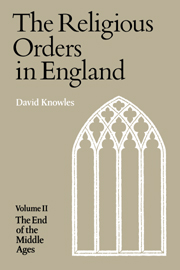Book contents
- Frontmatter
- Contents
- Preface
- List of Abbreviations
- Part One The Historical Framework
- Chap. I The opening of the period
- Chap. II Monks and canons at the university, 130c–1450
- Chap. III Patrons and architects: Ely and Gloucester
- Chap. IV Portraits of monks
- Chap. V Monks and friars in controversy
- Chap. VI Trends in speculation: Ockhamism, justification and grace
- Chap. VII Criticism of the religious in the fourteenth century
- Chap. VIII The spiritual life of the fourteenth century
- Chap. IX Developments within the orders: I
- Chap. X Developments within the orders: II
- Chap. XI The fortunes of the Cluniac houses and the alien priories
- Chap. XII The loosening of discipline
- Chap. XIII King Henry V
- Chap. XIV More portraits of monks
- Chap. XV The second century of visitation, 1350–1450
- Chap. XVI The spiritual life of the fifteenth century
- Part Two The Institutional Background
- Appendix I Chaucer's monk
- Appendix II Henry V and the Westminster recluse
- Appendix III Regulars as bishops
- Bibliography
- Index
Chap. IX - Developments within the orders: I
Published online by Cambridge University Press: 28 January 2010
- Frontmatter
- Contents
- Preface
- List of Abbreviations
- Part One The Historical Framework
- Chap. I The opening of the period
- Chap. II Monks and canons at the university, 130c–1450
- Chap. III Patrons and architects: Ely and Gloucester
- Chap. IV Portraits of monks
- Chap. V Monks and friars in controversy
- Chap. VI Trends in speculation: Ockhamism, justification and grace
- Chap. VII Criticism of the religious in the fourteenth century
- Chap. VIII The spiritual life of the fourteenth century
- Chap. IX Developments within the orders: I
- Chap. X Developments within the orders: II
- Chap. XI The fortunes of the Cluniac houses and the alien priories
- Chap. XII The loosening of discipline
- Chap. XIII King Henry V
- Chap. XIV More portraits of monks
- Chap. XV The second century of visitation, 1350–1450
- Chap. XVI The spiritual life of the fifteenth century
- Part Two The Institutional Background
- Appendix I Chaucer's monk
- Appendix II Henry V and the Westminster recluse
- Appendix III Regulars as bishops
- Bibliography
- Index
Summary
THE CISTERCIANS
During the fourteenth century a change occurred in the domestic life of the white monks which profoundly modified the character and activities of the Cistercians in England and Wales. This was the virtual disappearance of the converse who in the twelfth century had not only greatly outnumbered the choir monks in many abbeys, but had also been an essential factor in the Cistercian economy and the cause of its phenomenal success. It is scarcely too much to say that the perfecting of the converse-and-grange system had revolutionized both arable and pasture farming for the white monks, and when the conversi went or were no longer desired it was a sign that the influence of that revolution had passed.
Half a century ago this great change, like so much else, was attributed to the Black Death. The pestilence, so the argument ran, went far to eliminate the existing families of lay brothers, and in the decades which immediately followed the demand for labour and the rise in wages effectually prevented recruitment on a large scale. That many abbeys were hard hit is likely, and in one or two cases the actual figures of the losses are known, but it is clear from other evidence that the decrease of conversi had taken place very generally before 1350, while on the other hand rural conditions in the succeeding fifty years had not altered sufficiently to account for the virtual non-existence of the class throughout England.
- Type
- Chapter
- Information
- Religious Orders Vol 2 , pp. 125 - 143Publisher: Cambridge University PressPrint publication year: 1979

